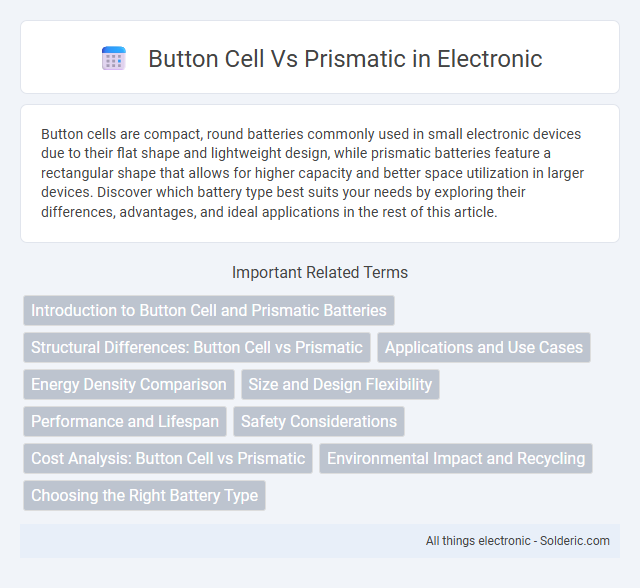Button cells are compact, round batteries commonly used in small electronic devices due to their flat shape and lightweight design, while prismatic batteries feature a rectangular shape that allows for higher capacity and better space utilization in larger devices. Discover which battery type best suits your needs by exploring their differences, advantages, and ideal applications in the rest of this article.
Comparison Table
| Feature | Button Cell Battery | Prismatic Battery |
|---|---|---|
| Shape | Small, round, coin-shaped | Flat, rectangular with rigid casing |
| Size | Compact, typically 5-25 mm diameter | Larger, customizable dimensions |
| Capacity | Low energy capacity (mAh range) | High energy capacity (Ah range) |
| Applications | Watches, calculators, hearing aids | Smartphones, laptops, electric vehicles |
| Energy Density | Lower energy density | Higher energy density |
| Manufacturing Cost | Low cost per unit | Higher cost due to design complexity |
| Durability | Limited cycles, disposable | Rechargeable, long cycle life |
| Voltage | Typically 1.5V to 3V | Typically 3.6V to 3.7V |
| Weight | Very lightweight | Heavier due to larger size |
Introduction to Button Cell and Prismatic Batteries
Button cell batteries are small, round, and compact power sources commonly used in watches, hearing aids, and small electronic devices due to their lightweight and long shelf life. Prismatic batteries feature a rectangular shape with a flat profile, providing higher energy capacity and efficient space utilization, making them popular in smartphones, tablets, and electric vehicles. Both battery types differ significantly in size, shape, and application, with button cells prioritizing convenience and prismatic cells focusing on enhanced energy density.
Structural Differences: Button Cell vs Prismatic
Button cells feature a compact, cylindrical shape with a flat, disc-like structure ideal for low-drain devices, while prismatic batteries have a rectangular, box-like design that maximizes space efficiency and capacity within slim electronic devices. The structural difference lies in the electrode arrangement and casing, where button cells have stacked layers forming a small profile, and prismatic cells utilize layered plates in a flat, elongated casing to enhance energy density. Your choice between button cell and prismatic depends on device size constraints and power requirements, with prismatic cells generally offering higher capacity and better space utilization.
Applications and Use Cases
Button cells are commonly used in small electronic devices like wristwatches, hearing aids, calculators, and small remote controls due to their compact size and long shelf life. Prismatic batteries, with their larger capacity and flat shape, are ideal for smartphones, tablets, and other portable electronics requiring higher energy density and efficient space utilization. The choice between button cells and prismatic batteries depends on the device's power requirements and physical design constraints.
Energy Density Comparison
Prismatic cells typically offer higher energy density compared to button cells, making them more suitable for applications requiring longer battery life in a compact form. Button cells, while smaller and ideal for low-drain devices, generally have lower energy density, limiting their use to small electronics like watches or hearing aids. When selecting a battery, consider your device's energy demands and space constraints to determine whether a prismatic or button cell best fits your needs.
Size and Design Flexibility
Button cells are compact and disc-shaped, ideal for small, lightweight devices requiring minimal power, whereas prismatic batteries offer larger sizes and a rectangular design that maximizes internal volume for higher capacity. The flat, customizable shape of prismatic batteries provides greater design flexibility, allowing engineers to tailor battery dimensions to fit specific device contours or space constraints. Your choice between button cell and prismatic batteries depends on the balance between size limitations and power needs in your device design.
Performance and Lifespan
Prismatic batteries typically offer higher energy density and longer lifespan compared to button cells, making them ideal for devices requiring sustained power over extended periods. Button cells provide reliable performance in low-drain applications but tend to have shorter operational lifespans due to limited capacity. Your choice between the two should consider the power demands and longevity requirements of your device.
Safety Considerations
Button cell batteries pose safety risks due to their small size, which increases the chance of accidental ingestion, especially by children, leading to serious injury or fatalities. Prismatic batteries, often used in larger devices, generally offer improved safety through integrated protective circuits that prevent overcharging, overheating, and short-circuiting. Your choice should weigh these safety features carefully to minimize hazards in your specific application.
Cost Analysis: Button Cell vs Prismatic
Button cells generally have a lower manufacturing cost due to their simple, compact design and minimal material usage, making them ideal for low-drain devices. Prismatic batteries, while more expensive to produce, offer higher energy density and better space efficiency, which can reduce overall system costs in applications requiring longer runtime and larger capacity. Evaluating total cost of ownership includes balancing the initial price difference against performance benefits and lifecycle longevity.
Environmental Impact and Recycling
Prismatic batteries generally offer better environmental benefits due to their larger size, which enables improved energy efficiency and easier recycling processes compared to button cells. Button cells contain hazardous materials such as mercury and cadmium, posing higher risks during disposal and making recycling more complex and less eco-friendly. Your choice can significantly influence environmental sustainability, as opting for prismatic batteries supports safer handling and more effective resource recovery.
Choosing the Right Battery Type
Choosing the right battery type depends on your device's size, power requirements, and lifespan expectations. Button cell batteries are ideal for compact devices like watches and hearing aids due to their small form factor and reliable voltage output. Prismatic batteries offer higher capacity and energy density, making them suitable for larger electronics and applications requiring longer runtime and more consistent power delivery.
Button cell vs prismatic Infographic

 solderic.com
solderic.com